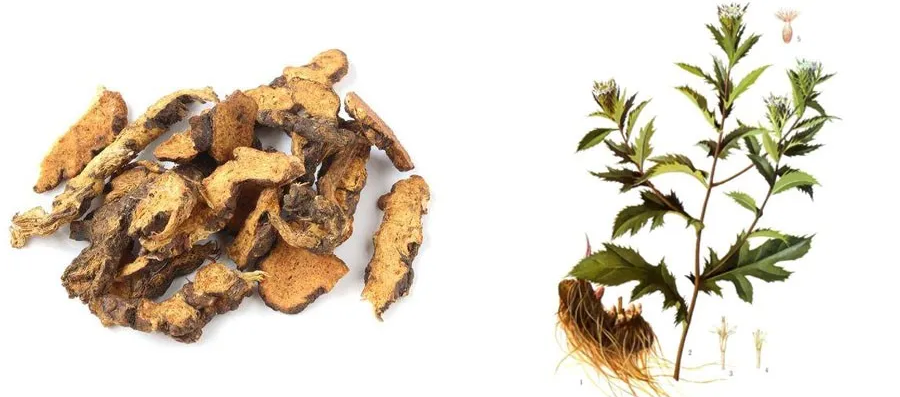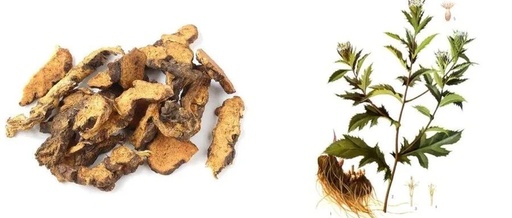 Click 【Herb Query】, then click the upper right corner 【···】to set as
Click 【Herb Query】, then click the upper right corner 【···】to set as  Starred/Top
Starred/Top for easy accessCang Zhu (Atractylodes) belongs to the Asteraceae family, primarily divided into Nan Cang Zhu (Southern Atractylodes) and Bei Cang Zhu (Northern Atractylodes), both growing in drier mountainous areas. Nan Cang Zhu is solid, with a flat break surface, yellowish-white, and has distinct brown-red oil glands scattered throughout, commonly referred to as “vermilion dots”. When cut, it emits a fragrant aroma, and if the break surface soon develops a white frost, it is considered the best quality. The main production areas are in Jiangsu and Henan, with the highest quality found in the Maoshan area of Jiangsu, hence it is called “Maoshu” or “Maoshan Cang Zhu”. In the past, the distribution center for Nan Cang Zhu was in Nanjing, also known as “Jing Cang Zhu” or “Jing Maoshu”.
for easy accessCang Zhu (Atractylodes) belongs to the Asteraceae family, primarily divided into Nan Cang Zhu (Southern Atractylodes) and Bei Cang Zhu (Northern Atractylodes), both growing in drier mountainous areas. Nan Cang Zhu is solid, with a flat break surface, yellowish-white, and has distinct brown-red oil glands scattered throughout, commonly referred to as “vermilion dots”. When cut, it emits a fragrant aroma, and if the break surface soon develops a white frost, it is considered the best quality. The main production areas are in Jiangsu and Henan, with the highest quality found in the Maoshan area of Jiangsu, hence it is called “Maoshu” or “Maoshan Cang Zhu”. In the past, the distribution center for Nan Cang Zhu was in Nanjing, also known as “Jing Cang Zhu” or “Jing Maoshu”.
Bei Cang Zhu is primarily produced in North China and is of inferior quality compared to Nan Cang Zhu. Cang Zhu can be wild or cultivated, often growing spontaneously in mountain villages. Historically, there were about four provinces cultivating Cang Zhu, namely Sichuan, Guangxi, Guizhou, and Fujian, with Guangxi producing the best quality, followed by Guizhou and Fujian, and Sichuan being the least.
1. Li Shizhen and Cang Zhu
Ancient texts state: “Zhu (Cang Zhu) is the essence of the mountains; consuming it can help one avoid hunger and achieve longevity, hence the elegant titles of mountain essence, immortal technique, and heavenly essence.” The character “Zhu” originally refers to the shape of its roots and leaves, as per the Six Writings. In the Japanese text “Wakan Yaku Kō”, it is also referred to as “Maoshu’s Treasure Box”.
The Cang Zhu produced in Jiangsu Maoshan has a unique fragrance, and when cut, it reveals seven vermilion dots that remain unchanged over time. Both the “Compendium of Materia Medica” and the “Chronicle of Jintan County” record: “Zhu is produced in the Shimen area of Maoshan, and those with vermilion dots when cut are considered rare treasures.”
It is said that during the Ming Dynasty, the great pharmacologist Li Shizhen discovered a tall and fragrant Cang Zhu while foraging for medicinal herbs on a cliff. Remarkably, this Cang Zhu grew on a piece of stone resembling a crane, with a white neck, gray feathers, and a red crown.
Li Shizhen carefully approached the rock and dug up this extraordinary herb with his medicinal hoe. After several digs, a small stone flew up and landed perfectly on the crane’s red crown, causing seven drops of blood to drip down from it.
Li Shizhen was astonished, and with a loud bang, the rock transformed into a beautiful crane, which let out three long cries and soared into the sky. Upon examining the Cang Zhu, he found seven bright red vermilion dots inside.
Since then, the vermilion dots of Maoshan Cang Zhu have never faded, and its efficacy surpasses that of Cang Zhu from other regions.
2. “To Achieve Longevity, Regularly Consume Mountain Essence”
Cang Zhu is an ancient Chinese medicinal herb, mentioned in the “Shennong Bencao Jing”: “Cang Zhu, when prepared as a decoction, can help one lose weight and prolong life.” The Jin Dynasty health scholar Ge Hong recorded in his book “Baopuzi”: “During the end of the Han Dynasty, a man named Wen from Nanyang escaped to Mount Hua, starving and on the verge of death. Someone taught him to eat Zhu, and he was no longer hungry. After several decades, he returned home, looking younger and feeling lighter, hence Zhu is called mountain essence, as the Shennong Bencao Jing states that to achieve longevity, one must regularly consume mountain essence.”
In ancient times, “Liu Juanzi made pills from its essence, named Shouzhong Jinwan, which can promote longevity.” Therefore, some practitioners in the Ming Dynasty also referred to Cang Zhu as “immortal technique”. The “Records of Immortals” also states: “Chen Zihuang obtained the essential formula for Zhu and became an immortal after consuming it. His wife, who suffered from fatigue and illness, recovered after using the Zhu method, living to 170 years old, and returned from the mountains carrying Zhu, never tiring, with a complexion and energy like that of a twenty-year-old.” Ming Dynasty scholar Xie Zhao’s “Wenhai Pisha” mentioned: “Medicines that benefit people, if taken continuously, can lead to longevity… Lin Ziming consumed Zhu for eleven years and felt light.”
In ancient medical prescriptions, many used Cang Zhu as a formula for prolonging life, such as the “Cang Zhu Gao” in “Deng Cai Bifeng Zhi” which states it “strengthens the spleen and stomach, whitens the complexion, and replenishes deficiencies, with great efficacy.” The “Shaoyang Dan” from “Liu Songshi Baoshoutang” uses one pound of processed Cang Zhu, twenty pounds of ripe mulberries, mixed into a paste, dried, and formed into honey pills the size of red beans, taken with wine, three times a day, claiming “within a year, white hair turns black, and within three years, the face resembles that of a youth.”
Another example is the “Guzhen Dan” from “Ruizhutang Fang”, which dries dampness and nourishes the spleen, assisting the stomach in solidifying the essence. It uses one pound of Maoshan Cang Zhu, divided into four parts, one part stir-fried with one tael of green salt, one part with one tael of Sichuan pepper, one part with one tael of Sichuan neem, and one part with one tael each of fennel and broken gu paper, and then ground into powder, boiled with wine, formed into pills, and taken with hollow rice. This combination uses Cang Zhu as the main ingredient to nourish the spleen and assist the stomach, enhancing the source of postnatal essence, while the addition of salt, pepper, neem, and fennel enhances appetite and retains the essence of food in the kidneys, effectively solidifying the essence and preserving vitality, especially suitable for those with weak spleen function.
Ancient physician Huangfu Ji had a famous formula called the “Elixir of Immortality”, which also used Cang Zhu as the main herb, processed in various ways: one pound soaked in wine, one pound in vinegar, one pound stir-fried with four taels of salt, and one pound with four taels of pepper, along with two pounds each of red and white He Shou Wu, five sheng of black beans and red dates, steamed until the beans are soft, dried, and ground into powder, mixed with mulberry juice to form a paste, spread in a dish, with the juice three fingers high, sun-dried and dew-drenched until dry, pounded into powder, and refined with honey into pills the size of walnuts, taken with wine, one hundred pills on an empty stomach. The original text states: “Taking it for seven days will not result in white hair.”
TCM experts believe that this method of using herbs aligns with the “Su Xiang, Cang Qi Fa Shi Lun” which states “the combination of flavors and taking them can replenish and benefit the essence.” To this day, the efficacy of Cang Zhu in “prolonging life and lightening the body with long-term use” still warrants further research.
3. Cang Zhu and Bai Zhu
In the “Shennong Bencao Jing”, there is no distinction between Cang Zhu and Bai Zhu. The Eastern Han physician Zhang Zhongjing used Bai Zhu in the “Shanghan Lun”, while in the “Jinkui”, he first used Chi Zhu, which refers to Cang Zhu. Therefore, the differentiation between Cang Zhu and Bai Zhu likely began with the TCM sage Zhang Zhongjing. Although Cang Zhu and Bai Zhu belong to the same category and share the same name, physicians throughout history have still made distinctions in their applications.
As the Qing Dynasty physician Zhang Yinan stated: “Bai Zhu is superior in nature, while Cang Zhu is inferior. For those wishing to tonify the spleen, Bai Zhu should be used; for those wishing to move the spleen, Cang Zhu should be used. If both tonification and movement are desired, they should be used in combination, such that if tonification is more than movement, Bai Zhu should be used more, and if movement is more than tonification, Cang Zhu should be used more.”
Cang Zhu and Bai Zhu can both strengthen the spleen and dry dampness, but Cang Zhu is superior in its ability to dry dampness and strengthen the stomach, while Bai Zhu is better at tonifying the spleen with a sweet and moist quality. Cang Zhu can raise yang and relieve depression, while Bai Zhu can tonify qi and nourish blood. Cang Zhu is pungent and drying, while Bai Zhu is sweet and moist, with more tonifying effects.
For example, the renowned modern TCM physician Wei Longxiang was known for using high doses of Bai Zhu (often over 60 grams) to treat elderly patients with qi deficiency and constipation, achieving excellent results. This reminds one of a poem by Song Dynasty poet Shao Bao about Bai Zhu: “Physicians value Bai Zhu from Tiantai, Shao Shou once brought candied Bai Zhu. After chewing, the fragrance filled the room, and the peach blossom stream dreamt of the Yao Tai.” This poem expresses gratitude to a friend for gifting Bai Zhu, indicating that the Bai Zhu from Tiantai Mountain is a genuine medicinal material, and after being soaked in honey by a friend, chewing it fills the room with fragrance and brings comfort to the body.
This poem also suggests that honey-soaked Bai Zhu is particularly beneficial for the elderly with weak constitutions and constipation, as it can utilize Bai Zhu’s ability to tonify the spleen and promote bowel movements, while also leveraging honey’s moistening properties. In summary, Cang Zhu is strong in its drying properties, effective against dampness, while Bai Zhu excels in its moistening properties, beneficial for tonifying the spleen and qi. The ancient saying states: “In areas with insufficient earth, Bai Zhu should be used to nourish it; in areas with excessive earth, Cang Zhu should be used to balance it.” This principle is based on the five elements, where insufficient earth is termed “bei jian”, and Bai Zhu should be used to tonify it, while excessive earth, where spleen dampness cannot be transformed, should use Cang Zhu to move the spleen. This is one of the differences in their applications.
Modern physician Zhang Shanlei believes that the main treatment of Zhu is for wind, cold, and dampness, which is primarily the function of Cang Zhu. Cang Zhu is aromatic and strong, particularly effective in dispelling wind and dampness; Bai Zhu is harmonizing, more stable, and specializes in tonifying the spleen. Therefore, Cang Zhu is often used to treat bi syndrome, which is another difference in their applications.
In ancient medical prescriptions, Cang Zhu is often used to improve vision and treat conditions such as night blindness, blurred vision, etc., while Bai Zhu is not used for these purposes. For instance, the “Shenghui Fang” uses processed Cang Zhu powder, mixed with pig or lamb liver, and cooked with millet, to be consumed before sleep. Alternatively, Cang Zhu can be mixed with Equisetum and taken as powder to treat blurred vision.
The “Youyou Xinshu” also mentions using Cang Zhu powder mixed with pig bile, cooked, and then used to fumigate the eyes, with the juice being consumed to treat infants with blurred vision. Bai Zhu has not been noted for its vision-enhancing properties in ancient or modern texts, and modern research confirms that this is due to Cang Zhu’s rich vitamin A content, which can treat vitamin A deficiency-related night blindness and keratomalacia. This is another difference in their applications.
In China, there is a traditional custom of purchasing Cang Zhu and Bai Zhu from herbal shops on the Dragon Boat Festival, burning them indoors to ward off epidemics and evil spirits, and to eliminate snakes and insects. “Regardless of wealth, this custom is upheld every year, becoming an unbreakable tradition.” This is because “Cang Zhu has a strong aroma, more potent than Bai Zhu, capable of penetrating deeply, dispelling foul odors, and overcoming the unwholesome qi of the four seasons.”
Zhang Shanlei also agrees, stating that “diseases caused by epidemics often use this herb, which is most effective in dispelling foul and turbid qi. In damp and gloomy environments, it is advisable to burn this herb before residing there.”
According to the “Shuinan Hanji”: “Fan Wenzheng’s residence must first have a well dug, and several pounds of green Zhu placed inside to ward off pestilence.”
Modern experiments have shown that burning Cang Zhu and Ai Ye has a purifying effect on indoor air, effectively killing pathogens such as Mycobacterium tuberculosis, Bacillus subtilis, Escherichia coli, Pseudomonas aeruginosa, and Staphylococcus aureus, which is another use that Bai Zhu does not possess.
End of text. Thank you for your patience in reading. If you find it interesting, please click “ Like” and “Read”~
Like” and “Read”~
▼Previous Highlights▼Three Common Spleen and Stomach Tonic Formulas, Effective for Wind-Cold Cough and Asthma, Classic Recipes for Strengthening Spleen and Stomach with Just Three Ingredients


